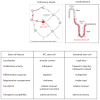Keeping it together: Pulmonary alveoli are maintained by a hierarchy of cellular programs
- PMID: 26201286
- PMCID: PMC5679707
- DOI: 10.1002/bies.201500031
Keeping it together: Pulmonary alveoli are maintained by a hierarchy of cellular programs
Abstract
The application of in vivo genetic lineage tracing has advanced our understanding of cellular mechanisms for tissue renewal in organs with slow turnover, like the lung. These studies have identified an adult stem cell with very different properties than classically understood ones that maintain continuously cycling tissues such as the intestine. A portrait has emerged of an ensemble of cellular programs that replenish the cells that line the gas exchange (alveolar) surface, enabling a response tailored to the extent of cell loss. A capacity for differentiated cells to undergo direct lineage transitions allows for local restoration of proper cell balance at sites of injury. We present these recent findings as a paradigm for how a relatively quiescent tissue compartment can maintain homeostasis throughout a lifetime punctuated by injuries ranging from mild to life-threatening, and discuss how dysfunction or insufficiency of alveolar repair programs produce serious health consequences like cancer and fibrosis.
Keywords: AT2 cell; alveoli; lineage tracing; lung; repair; stem cell; transdifferentiation.
© 2015 WILEY Periodicals, Inc.
Conflict of interest statement
The authors have no conflicts of interest to disclose.
Figures





Similar articles
-
Heterogeneous groups of alveolar type II cells in lung homeostasis and repair.Am J Physiol Cell Physiol. 2020 Dec 1;319(6):C991-C996. doi: 10.1152/ajpcell.00341.2020. Epub 2020 Sep 9. Am J Physiol Cell Physiol. 2020. PMID: 32903031 Free PMC article. Review.
-
Alveolar progenitor and stem cells in lung development, renewal and cancer.Nature. 2014 Mar 13;507(7491):190-4. doi: 10.1038/nature12930. Epub 2014 Feb 5. Nature. 2014. PMID: 24499815 Free PMC article.
-
Ager-CreERT2: A New Genetic Tool for Studying Lung Alveolar Development, Homeostasis, and Repair.Am J Respir Cell Mol Biol. 2018 Dec;59(6):706-712. doi: 10.1165/rcmb.2018-0125OC. Am J Respir Cell Mol Biol. 2018. PMID: 30011373 Free PMC article.
-
Design of peripheral airways for efficient gas exchange.Respir Physiol Neurobiol. 2005 Aug 25;148(1-2):3-21. doi: 10.1016/j.resp.2005.03.005. Respir Physiol Neurobiol. 2005. PMID: 15921964
-
The alveolus: Our current knowledge of how the gas exchange unit of the lung is constructed and repaired.Curr Top Dev Biol. 2024;159:59-129. doi: 10.1016/bs.ctdb.2024.01.002. Epub 2024 Mar 6. Curr Top Dev Biol. 2024. PMID: 38729684 Review.
Cited by
-
KRAS(G12D) drives lepidic adenocarcinoma through stem-cell reprogramming.Nature. 2023 Jul;619(7971):860-867. doi: 10.1038/s41586-023-06324-w. Epub 2023 Jul 19. Nature. 2023. PMID: 37468622 Free PMC article.
-
Abnormal respiratory progenitors in fibrotic lung injury.Stem Cell Res Ther. 2022 Feb 7;13(1):64. doi: 10.1186/s13287-022-02737-y. Stem Cell Res Ther. 2022. PMID: 35130980 Free PMC article. Review.
-
An organoid-derived bronchioalveolar model for SARS-CoV-2 infection of human alveolar type II-like cells.EMBO J. 2021 Mar 1;40(5):e105912. doi: 10.15252/embj.2020105912. Epub 2021 Jan 11. EMBO J. 2021. PMID: 33283287 Free PMC article.
-
Controversies Surrounding the Origin of Hepatocytes in Adult Livers and the in Vitro Generation or Propagation of Hepatocytes.Cell Mol Gastroenterol Hepatol. 2021;11(1):273-290. doi: 10.1016/j.jcmgh.2020.09.016. Epub 2020 Sep 28. Cell Mol Gastroenterol Hepatol. 2021. PMID: 32992051 Free PMC article. Review.
-
Stem cells and lung regeneration.Am J Physiol Cell Physiol. 2020 Oct 1;319(4):C675-C693. doi: 10.1152/ajpcell.00036.2020. Epub 2020 Aug 12. Am J Physiol Cell Physiol. 2020. PMID: 32783658 Free PMC article. Review.
References
-
- Bertalanffy FD, Leblond CP. Structure of respiratory tissue. Lancet. 1955;269:1365–8. - PubMed
-
- Kauffman SL. Cell proliferation in the mammalian lung. Int Rev Exp Pathol. 1980;22:131–91. - PubMed
-
- Uhal BD. Cell cycle kinetics in the alveolar epithelium. Am J Physiol. 1997;272:L1031–45. - PubMed
-
- Leblond CP. Classification of Cell Populations on the Basis of Their Proliferative Behavior. Natl Cancer I Monogr. 1964;14:119–50. - PubMed
-
- Buckingham ME, Meilhac SM. Tracing cells for tracking cell lineage and clonal behavior. Dev Cell. 2011;21:394–409. - PubMed
Publication types
MeSH terms
Substances
Grants and funding
LinkOut - more resources
Full Text Sources
Other Literature Sources

